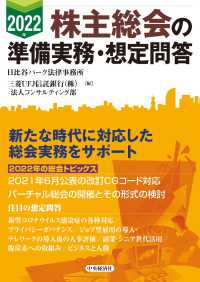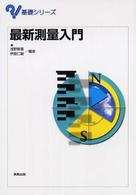- ホーム
- > 洋書
- > 英文書
- > Computer / General
Full Description
CMMI (R) for Acquisition (CMMI-ACQ) describes best practices for the successful acquisition of products and services. Providing a practical framework for improving acquisition processes, CMMI-ACQ addresses the growing trend in business and government for organizations to purchase or outsource required products and services as an alternative to in-house development or resource allocation. Changes in CMMI-ACQ Version 1.3 include improvements to high maturity process areas, improvements to the model architecture to simplify use of multiple models, and added guidance about using preferred suppliers.CMMI (R) for Acquisition, Second Edition, is the definitive reference for CMMI-ACQ Version 1.3. In addition to the entire revised CMMI-ACQ model, the book includes updated tips, hints, cross-references, and other author notes to help you understand, apply, and quickly find information about the content of the acquisition process areas. The book now includes more than a dozen contributed essays to help guide the adoption and use of CMMI-ACQ in industry and government. Whether you are new to CMMI models or are already familiar with one or more of them, you will find this book an essential resource for managing your acquisition processes and improving your overall performance.The book is divided into three parts.Part One introduces CMMI-ACQ in the broad context of CMMI models, including essential concepts and useful background. It then describes and shows the relationships among all the components of the CMMI-ACQ process areas, and explains paths to the adoption and use of the model for process improvement and benchmarking. Several original essays share insights and real experiences with CMMI-ACQ in both industry and government environments.Part Two first describes generic goals and generic practices, and then details the twenty-two CMMI-ACQ process areas, including specific goals, specific practices, and examples. These process areas are organized alphabetically and are tabbed by process area acronym to facilitate quick reference.Part Three provides several useful resources, including sources of further information about CMMI and CMMI-ACQ, acronym definitions, a glossary of terms, and an index.
Contents
Foreword xiPreface xiiiBook Acknowledgments xixPart One: About CMMI for Acquisition 1Chapter 1: Introduction 3About Process Improvement 5About Capability Maturity Models 6Evolution of CMMI 7CMMI Framework 9CMMI for Acquisition 10Chapter 2: Process Area Components 11Core Process Areas and CMMI Models 11Required, Expected, and Informative Components 11Components Associated with Part Two 12Supporting Informative Components 18Numbering Scheme 20Typographical Conventions 20Chapter 3: Tying It All Together 25Understanding Levels 25Structures of the Continuous and Staged Representations 26Understanding Capability Levels 29Understanding Maturity Levels 31Process Areas 36Achieving High Maturity 42Chapter 4: Relationships Among Process Areas 45Project Processes 47Organizational Processes 51Support Processes 52High Maturity Processes 54Chapter 5: Using CMMI Models 57Adopting CMMI 57Your Process Improvement Program 58Selections That Influence Your Program 58CMMI Models 59Using CMMI Appraisals 60Appraisal Requirements for CMMI 61SCAMPI Appraisal Methods 61Appraisal Considerations 62CMMI Related Training 63Chapter 6: Essays on CMMI-ACQ in Government and Industry 65Critical Issues in Government Acquisition 65The IPIC Experience 74CMMI: The Heart of the Air Force's Systems Engineering Assessment Model and Enabler to Integrated Systems Engineering-Beyond the Traditional Realm 86Lessons Learned by DGA on CMMI-ACQ 95CMMI-ACQ and the "Three R's" of DoD Acquisition 100Use of CMMI at the U.S. Government Accountability Office 105An Industry Perspective on CMMI-ACQ 108CMMI-ACQ in Industry: Future Possibilities 122Acquisition Strategy: Planning for Success 125Agreements: They Are Not Just with Suppliers 131Acquisition Verification: The Challenges 133Transition to Operations: Delivering Value 137Interoperable Acquisition 139Acquisition Agility 143Employing Agile in DoD Acquisition 151Acquisition Improvement: Identifying and RemovingProcess Constraints 156Expanding Capabilities Across the Constellations 163Part Two: Generic Goals and Generic Practices, and the Process Areas 167Generic Goals and Generic Practices 169Agreement Management 191Acquisition Requirements Development 199Acquisition Technical Management 215Acquisition Validation 229Acquisition Verification 237Causal Analysis and Resolution 247Configuration Management 257Decision Analysis and Resolution 271Integrated Project Management 281Measurement and Analysis 299Organizational Process Definition 319Organizational Process Focus 333Organizational Performance Management 349Organizational Process Performance 369Organizational Training 383Project Monitoring and Control 395Project Planning 411Process and Product Quality Assurance 443Quantitative Project Management 451Requirements Management 471Risk Management 479Solicitation and Supplier Agreement Development 497Part Three: The Appendices 515Appendix A: References 517Appendix B: Acronyms 523Appendix C: CMMI Version 1.3 Project Participants 527Appendix D: Glossary 535Book Contributors 567Index 581








